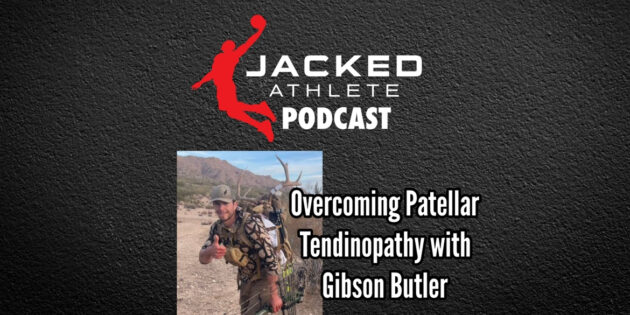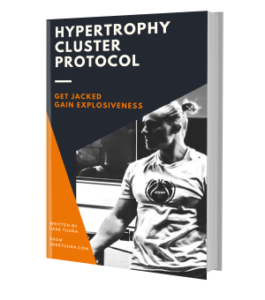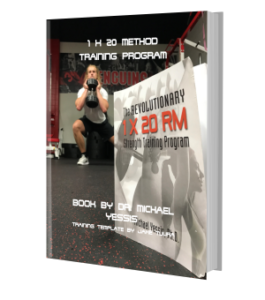“My patellar tendon pain was brought on by hiking and hunting. And the kind of hunting that specifically you’re doing out west, it’s a lot of vertical feet on very steep slopes with very loose footing. So it is a lot of quick movements, slipping, catching yourself. And I think it is a very tendon heavy pursuit.”
Early patellar tendinopathy: “It started early, like when I was 12 or 13, right about the time I hit puberty, I started getting pain in the front of the knee. And I think it actually started in like junior high football. It kind of came and went throughout junior high, high school sports. And sometimes it was really bad. Sometimes I never noticed it.”
Later patellar tendinopathy: “And then continuing into college, it was kind of the same thing on and off. If I played like a bunch of pickup basketball back to back, it would flare up. And it would flare up if I had a big like three or four days of hunting where I was doing a lot of miles and vertical feet every day and presumably not sleeping very well because you’re sleeping on rocks most of the time. And then. Once I graduated college was when it got to the point where it was too much that I couldn’t deal with it.”
Equipment operator job: “So essentially I was sitting on my ass for 14 to 15 hours a day. And then on the weekends I would go and do the same stuff that I had always done, hiking and hunting. And I just think that difference in activity levels from the weekdays to weekends when I was hunting really flared it up.”
“I was actually on a hunt in Idaho and was up kind of in these cliffs and the pain got so bad that I just had to turn around and go to the truck. I could barely make it to the truck, like hardly putting any weight on my left leg. That was kind of my, my point where I realized I really needed to figure out something to fix it because it was going to keep me from doing what I love to do, which is hunting.”
“I can go uphill for as long as I need to. It’s the downhill that has always been the problem.”
Past partial tear: “I remember one specific time it was like junior year of high school and had just done a big practice and a lift and I was dunking and I jumped off my left and I just felt something in my knee, like in my patellar tendon. I didn’t know what it was. But it was enough that I was like, I should probably stop for the night. And I think it was probably a fairly significant tear. And I eventually did get imaging on it over like about a year and a half ago. And there was small tears pretty much throughout the tendon. And yeah, I think I did a lot of damage as a kid.”
“If I had done a big climb to get up to somewhere where I was gonna glass from, the downhill back to either the truck or camp was always, if it was long enough, it was gonna be painful.”
“Depending on the kind of hunt you’re doing, my day pack is anywhere from 20 to 30 pounds. But if you’re doing a multi-day backpacking trip, depending on how much stuff you bring, it’ll be anywhere from 45 to 60 pounds on your back the whole time. So you can imagine how much stress that adds.”
ATG: “I did knees over toes for six to eight months and I think it made me worse. I was to the point where I couldn’t engage my quad muscle and none of those exercises allowed me to do that. Like I didn’t get a quad burn or a quad pump for probably three or four years until I found your stuff.”
Stem Cells: “After that six months of ATG, I got through it and was like, okay, I’ve done this for this long. have zero results. I have to start looking into other things. I got one injection of, it’s called placental tissue matrix. I don’t know if that’s like stem cells or some derivative of that, but that’s what I ended up getting. like one or two months later, going in for my follow-up, I pretty much just told the guy like, I still in a lot of pain.”
PRP: “Ended up giving me a PRP injection. A couple months after that, my knee pain was probably the worst that it’s ever been.”
Tenex: “I went to Pocatello, Idaho and got that done and started PT to recover from that. And I think that is right about the time that I found your stuff.”
Quadriceps: “I couldn’t get it to engage. think that I had just I had torched it so bad that my brain just completely shut it off. I don’t think I got it to engage until I started doing isometrics.”
Hunting while rehabbing: “I was doing easier hunts. I actually, I’m from around here, so I have permission on a couple pieces of private ground to hunt. And I remember one time I crutched out like a mile and a half to a ground blind and shot a cow elk with my bow out of it while I was on crutches… I was doing like a lot more whitetail hunting, a lot more flatland stuff, ⁓ and not going crazy steep and deep into the mountains.”
After stem cells: “I think it was like a week of non-weight bearing and then slowly reintroduce activity, but there wasn’t any recommendation or insistence on physical therapy or anything to help build muscle to recover from it.”
“Once I started running JKP, the biggest thing that I noticed was that I couldn’t cheat the isometrics. Like I had to engage my quad muscle. And I noticed that if I, if I loaded consistently either every day or six days a week, my, my knees felt infinitely better.”
“Leg extension has been the best for me. Another big, one big thing that’s helped me a lot is I just bought a leg extension machine and put it in my living room. So I wake up and grab my coffee and read emails while I’m doing leg extensions every morning. And it makes it lot easier to do twice a day because I don’t have to go to the gym twice a day… And yeah, the leg extension I think has been the most consistent. It always feels good. Like the other types of isometrics feel good, but not as consistently as the leg extension for me.”
“I think there was some pain relief right off the bat just from doing isometrics, I think that it had some kind of effect where it just made my knees feel better. It was almost like they would warm my knees up for the day. And then as far as like ability to jump and land and cut, that started coming back probably three or four months into it, doing all that without pain.”
“That’s the goal is to just be uninhibited in the woods, like, and never have to worry about pain in my knees when I’m out there.”
“I’m pretty bad at saying no to going on a hunt. So I probably did a lot more pushing through pain than I should have.”
“There’s pain here and there, not nearly as much now, but I probably go to a way more like posterior chain dominant way of moving down the mountain than I would.”
BPC-157: “Honestly, I’m to the point now where I’ve just fallen for every snake oil salesman that there is out there. So I really wish that I could get a good placebo effect from something like that. But at this point, I kind of assume that everything’s bullshit. I don’t get placebo for much.”
“The day after and even the same day that I do heavy squats, my knees feel amazing. Like I’m jumping around like a kangaroo, zero pain at all. So that’s been kind of interesting and I think that’s been really helpful. Just being able to really load up a barbell and do some squats, I think has been really good for me. And I think if I just stay on that path and keep doing the right things and try not to beat up my tendon too much throughout the summer, I’ll probably be coming close to 100 % by fall.”
“My top three would be quad extension, heavy split squats, and heavy zerchers. I think those three are the ones that I do and I know my knees are gonna feel really good during and after. And I get a great quad pump from every one of those.”
Being okay with lengthy rehab: “Because I’m getting better. I mean, at, at the end of the day, I’m progressing towards the goal. And, I know that worrying about how quickly it’s happening isn’t the most productive thing to do. And if I just get stronger, it’s going to continue to get better. So that’s kind of my take on it. And I’m just happy that I’m trending in the right direction because that wasn’t the case for a long time.”
“Biggest piece of advice would be, be very wary of people claiming to have a magical cure to it and load it. Load it as much as you can. And if it gets mad at you, stop. But if it doesn’t, keep going.”
Gibson on Instagram: https://www.instagram.com/gibsonbutler.596/



